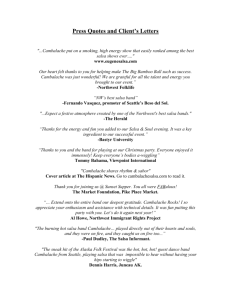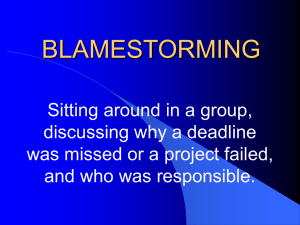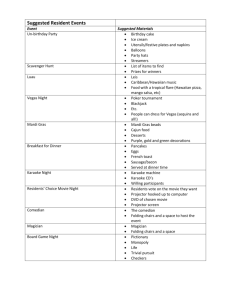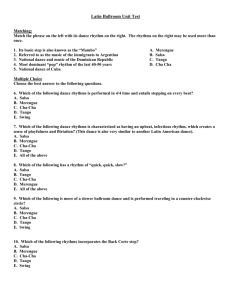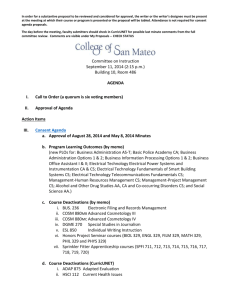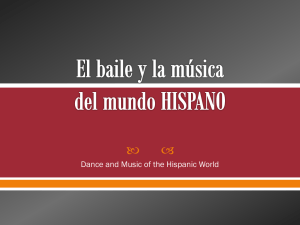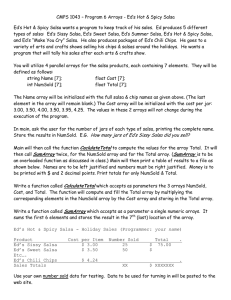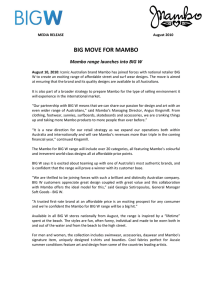Salsa Roots
advertisement
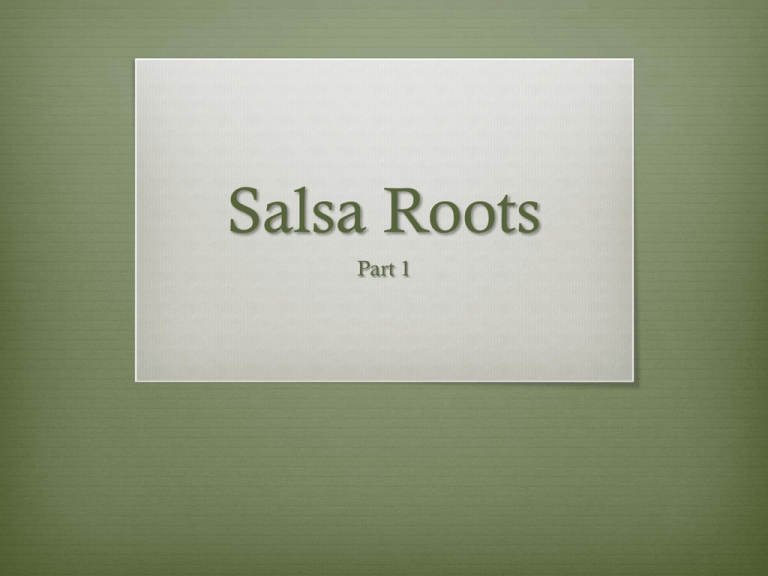
Salsa Roots Part 1 Bellwork Merengue- Dominican style of music and dance Bolero- Cuban dance in two Mambo- A Latin dance of Cuba Guaguancó—an Afro-Cuban rumba Rancheras—A Mexican vocal song with instrumental accompaniment vallenato-A vocal song with accordion accompaniment from Columbia Outcomes Grammar: Learn basic facts about the roots of salsa music Logic: Practice playing specific Latin rhythms Announcements Test on Salsa Roots Thursday, December 12th. Reading #15 due Tuesday December 10th Outline of slide show due Tuesday December 10th Bring your electronic devices tomorrow. We will be working on the final project. Slideshow Outline: Example Name: Francisca Wise Topic: Hand-clapping Games Artist examples: Maria, Kayla, Darianna Musical Examples: “I don’t want to go to Mexico”, “Pepsi” Slide 1-3: History and background of Hand-clapping Games in the USA Slide 4: Hand clapping games from around the world Outline part 2 Slide 5: Transition to hand clapping games from my neighborhood Slide 6: Miss Mary Mack Slide 7: Speed (Numbers) Slide 8: Pictures Slide 9: Clips from neighborhood interviews—cross- generational—girls and mothers Slide 10: Influence of hand clapping games on childhood social development Pre-Knowledge Define salsa: What part of the world does salsa music come from? Who dances salsa? Have you ever danced salsa? What instruments are used in a salsa band? Merengue Merengue Rhythm Merengue Learn the Merengue Rhythm! Put both hands on your left knee. The first hit is in the right hand RLRR RLRLRR Start on with both hands on your left knee. Move the large R to your right knee RLRR RLRLRR Try it on the congas Bolero—Dos Almos Mambo Rhythm R R L R R L R R R L R R L R Pass me the ketchup would you Please pass the ketchup would you Mambo Learn the Mambo Rhythm! Put your right hand on your right knee and your left hand on your left knee The first hit is in the right hand RRLRRLR RRLRRLR Try it on the congas Rancheras Vallenato Salsa is… An artistic articulation of urban life A reaffirmation of class conflict A source of identity in Latin America Guided Notes Panethnicity is the grouping of people into one large group based on similar physical characteristics, sharing of a common language, common culture, or sharing of a common religion. Because it is Pan-Latino, Salsa music does not have a fixed definition. Salsa has roots in antecedents in folklore and in black counterplantation culture in oppositionality and resistance. Active Listening #1 Name all the instruments you hear: The saxophone has a recurring melodic motive—it is ascending or descending? Quizas, Quizas, Quizas Quizas means perhaps. The trumpet lines are influenced by rancheras music. CFU: Snowball Create one question from the facts you learned in our class today. Write it on a piece of paper along with your name and then crumple it up and throw it to the front of the room. When you are instructed to, go up and choose one snowball. Open it up and answer the question then turn it in. This will count as your exit ticket for today. Guided Notes The anglo mainstream in America often appropriates and co-opts the cultural productions of less dominant groups. Salsa was born in the Latino barrios of 1960’s New York. Salsa was heavily influenced by the Cuban music of the 1950’s. Son is a Cuban secular musical dance form that originated in the rural areas of eastern Cuba. Other Cuban influences include the use of timbales, the higher pitch range, of salsa vocal lines, congas, clave rhythm. Play it! Timbale Rhythm Say the following: Pass the ketchup in east St. Louis With your pencil tap the metal of the eraser on the metal of your chair. Timbales Active Listening #2 Which instrument “screams”? Give three adjectives which describe this Mambo Just the Facts Mambo #8 Mambo literally means conversation of the gods in kikongo. Perez Prado was known as the King of Mambo. CFU: Dance the Mambo R-back L R front L-forward R step L back Quick Quick Slow Map Quest ID: Cuba, Puerto Rico, Dominican Republic, Venezuela, Columbia
